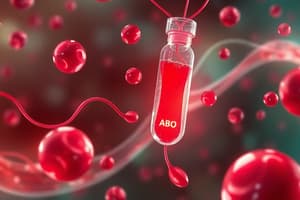Podcast
Questions and Answers
A patient with severe anemia requires a blood transfusion to improve oxygen-carrying capacity. Which blood product is MOST appropriate for this specific purpose?
A patient with severe anemia requires a blood transfusion to improve oxygen-carrying capacity. Which blood product is MOST appropriate for this specific purpose?
- Fresh frozen plasma
- Packed red blood cells (PRBC) (correct)
- Whole blood
- Albumin
During a blood transfusion, a nurse observes the patient developing chills, fever, and lower back pain. Which of the following is the MOST likely cause of these symptoms?
During a blood transfusion, a nurse observes the patient developing chills, fever, and lower back pain. Which of the following is the MOST likely cause of these symptoms?
- Aseptic technique failure during insertion
- Hypovolemia caused by underlying condition.
- Transfusion reaction due to incompatibility. (correct)
- Fluid overload from rapid infusion.
A physician orders a blood transfusion for a patient. Prior to initiating the transfusion, what is the MOST critical nursing action to ensure patient safety?
A physician orders a blood transfusion for a patient. Prior to initiating the transfusion, what is the MOST critical nursing action to ensure patient safety?
- Verify the blood product and patient identification. (correct)
- Establish intravenous access with a small gauge catheter.
- Administer pre-medications as prescribed.
- Inform the patient about the potential risks involved.
A patient undergoing a blood transfusion suddenly develops dyspnea and a cough. On auscultation, the nurse notes crackles in the lungs. What immediate action should the nurse take?
A patient undergoing a blood transfusion suddenly develops dyspnea and a cough. On auscultation, the nurse notes crackles in the lungs. What immediate action should the nurse take?
Why is 0.9% normal saline (PNSS) the only solution used to prime and flush a blood transfusion set?
Why is 0.9% normal saline (PNSS) the only solution used to prime and flush a blood transfusion set?
A patient is scheduled for an autologous blood transfusion. What does this type of transfusion involve?
A patient is scheduled for an autologous blood transfusion. What does this type of transfusion involve?
What is the primary purpose of crossmatching blood prior to a transfusion?
What is the primary purpose of crossmatching blood prior to a transfusion?
A patient with a known history of multiple transfusions is about to receive another unit of packed red blood cells. Which of the following pre-transfusion actions is MOST important to consider?
A patient with a known history of multiple transfusions is about to receive another unit of packed red blood cells. Which of the following pre-transfusion actions is MOST important to consider?
Two nurses are verifying a unit of blood at the patient's bedside before transfusion. Which of the following discrepancies would require notifying the charge nurse and blood bank?
Two nurses are verifying a unit of blood at the patient's bedside before transfusion. Which of the following discrepancies would require notifying the charge nurse and blood bank?
During a blood transfusion, a nurse observes the client exhibiting signs of a possible transfusion reaction after the initial 15 minutes. What is the MOST appropriate initial nursing intervention?
During a blood transfusion, a nurse observes the client exhibiting signs of a possible transfusion reaction after the initial 15 minutes. What is the MOST appropriate initial nursing intervention?
After obtaining a unit of blood from the blood bank, what is the MOST important time-sensitive action a nurse should take?
After obtaining a unit of blood from the blood bank, what is the MOST important time-sensitive action a nurse should take?
A nurse is preparing to administer a blood transfusion. After spiking the blood bag, squeezing the drip chamber, and hanging the unit, what is the next critical step?
A nurse is preparing to administer a blood transfusion. After spiking the blood bag, squeezing the drip chamber, and hanging the unit, what is the next critical step?
During the first 15 minutes of a blood transfusion, a client reports itching and develops a localized rash. After stopping the transfusion, what is the MOST important next step for the nurse?
During the first 15 minutes of a blood transfusion, a client reports itching and develops a localized rash. After stopping the transfusion, what is the MOST important next step for the nurse?
What is the primary rationale for using a dedicated blood administration set with a filter during a blood transfusion?
What is the primary rationale for using a dedicated blood administration set with a filter during a blood transfusion?
Why is normal saline the only solution used to prime and flush a blood transfusion line?
Why is normal saline the only solution used to prime and flush a blood transfusion line?
Once the blood transfusion is complete, what is the purpose of flushing the IV line with normal saline?
Once the blood transfusion is complete, what is the purpose of flushing the IV line with normal saline?
Flashcards
Blood Transfusion
Blood Transfusion
Introduction of whole blood or blood components into venous circulation.
Purpose of Blood Transfusion
Purpose of Blood Transfusion
To restore blood volume, oxygen-carrying capacity, or administer a specific missing blood component.
Common Blood Products
Common Blood Products
Whole blood, Packed red blood cells (PRBC), Fresh frozen plasma, Platelets, Albumin, Cryoprecipitate and Plasma protein factor.
Blood Typing
Blood Typing
Signup and view all the flashcards
Crossmatching Blood
Crossmatching Blood
Signup and view all the flashcards
Preparing Blood Bag
Preparing Blood Bag
Signup and view all the flashcards
Pre-Transfusion Assessment
Pre-Transfusion Assessment
Signup and view all the flashcards
Steps Before Blood Transfusion
Steps Before Blood Transfusion
Signup and view all the flashcards
Spiking the Blood Bag
Spiking the Blood Bag
Signup and view all the flashcards
Priming the Tubing
Priming the Tubing
Signup and view all the flashcards
Blood Component Verification
Blood Component Verification
Signup and view all the flashcards
Essential Blood Information
Essential Blood Information
Signup and view all the flashcards
Transfusion Reaction Signs
Transfusion Reaction Signs
Signup and view all the flashcards
Mismatched Blood Info
Mismatched Blood Info
Signup and view all the flashcards
Flushing with Saline
Flushing with Saline
Signup and view all the flashcards
Initial Transfusion Rate
Initial Transfusion Rate
Signup and view all the flashcards
Study Notes
- Blood transfusion is introducing whole blood or its components into a patient's venous circulation.
- The purpose of blood transfusion is to restore blood volume, oxygen-carrying capacity, and administer necessary blood components.
Blood Products
- Common blood products include whole blood, packed red blood cells (PRBC), autologous blood, fresh frozen plasma, platelets, albumin, cryoprecipitate, and plasma protein factor.
Blood Groups
- Blood groups are categorized as Group A, Group B, Group AB, and Group O, based on the presence of specific antigens on red blood cells and corresponding antibodies in the plasma.
- Group A has A antigens on red blood cells and anti-B antibodies in the plasma.
- Group B has B antigens on red blood cells and anti-A antibodies in the plasma.
- Group AB has both A and B antigens on red blood cells and no antibodies in the plasma.
- Group O has no antigens on red blood cells and both anti-A and anti-B antibodies in the plasma.
Blood Rh Factor
- The Rh factor determines if a person's blood is positive or negative.
Blood Transfusion Equipment
- Essential equipment includes the blood product, PNSS (0.9% Normal Saline Solution), a BT set (Y-set), IV catheters and needles, clean gloves, alcohol swabs, an IV pole, and optionally, an infusion pump.
Blood Typing and Crossmatching
- Blood typing determines the presence of ABO and Rh antigens in a patient's blood.
- Crossmatching identifies potential interactions between minor antigens and corresponding antibodies by using the Direct Coombs test
Transfusion Reactions
- Transfusion reactions can be allergic, febrile, or hemolytic, and range from mild to severe.
- Allergic reactions include facial flushing and hives/rash.
- Febrile reactions present as fever, chills, anxiety, and headache.
- Hemolytic reactions: hemoglobinuria, chest pain, apprehension, low back pain, chills, fever, tachycardia, and increased respiratory rate.
Administering the Transfusion
- Prior to a blood transfusion, assess the client's vital signs, physical condition (including fluid balance and the status of the infusion site), check for unusual symptoms, and confirm the number and type of units, desired infusion speed, pre-medications, and patient's consent.
- Check the IV line, hand hygiene and apply gloves,
- Prepare the infusion equipment, close all clamps on the Y-set, spike the saline solution, and hang the IV bag.
- Open the upper clamp on the saline to cover the filter, prime the tubing, then connect to the client and start the saline solution.
- Mix the blood bag, expose the port, spike with the remaining Y set, and hang on the IV pole.
- Close the upper clamp below the saline and open the upper clamp below the blood bag, then readjust the flow rate.
- Observe the client for the initial 15 minutes at a slow flow rate (1-2ml/min) while assessing for any transfusion reactions and checking vital signs.
- Adjust the flow rate after 15 minutes if no reactions are observed.
- Document the procedure with its start date and time, vital signs, blood type, sequence number, catheter size and rate, completion date and time, and the amount absorbed.
- The blood should not be left at room temperature for more than 30 minutes
Studying That Suits You
Use AI to generate personalized quizzes and flashcards to suit your learning preferences.




